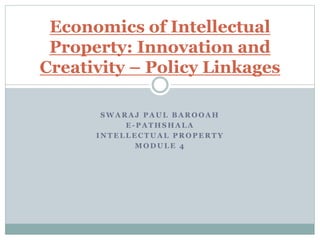
Ipr goods
- 1. S W A R A J P A U L B A R O O A H E - P A T H S H A L A I N T E L L E C T U A L P R O P E R T Y M O D U L E 4 Economics of Intellectual Property: Innovation and Creativity – Policy Linkages
- 2. 1. Introduction IP’s role in modern society cannot be understated. Important shaper of how new technologies are created, distributed and accessed. It was not long before the Law and Economics movement led to the economic analysis of IP First wave of scholars – Focused on IP as drivers of economic activity Second wave scholars – Placed IP within broader societal context.
- 3. 2. Economic Analysis Four major schools of thought on IP – Natural Rights theory, Personhood theory, Social Welfare Theory, and Utilitarian Theory. Economic analysis focuses on Utilitarian theory – two questions: What is ‘maximum social welfare’ How can this be applied to IP law and policy Maximum social welfare – “Kaldor Hicks” or “Wealth Maximization”
- 4. 2. Economic Analysis 3 methods of applying this to IP policy Incentive theory – Efficiency gains (from greater rate of innovation) > deadweight losses + informational loss Property Rights as optimal determinants of consumer welfare enhancing patterns of productivity Reducing duplicative or uncoordinated research / innovation activity
- 5. Public and Private Goods Public Goods, such as “information” are non- rivalrous and non-excludable in nature. Non-rivalrous good: Can be used/consumed infinite number of times without loss in good. E.g.: An apple is a rivalrous good. Once consumed, it cannot be consumed by anyone else. A book is a non-rivalrous good. It can be read over and over again. Non-excludable good: Usage by multiple parties (at a time) is not restricted. E.g,: A book cannot be used by many people at the same time. The light from a lighthouse can be.
- 6. Public and Private Goods
- 7. 2.1 Incentive theory Therefore information goods are most efficiently used when they are freely and widely consumed. However, if freely and widely consumed, how does one recuperate investments made in creating such information good? Especially when easy to reverse engineer and re-construct. Logical corollary is little incentive to create information goods To create incentives, artificial legal restrictions are created –> IPRs.
- 8. 2.1 Incentive theory Allowing IPRs = allowing inefficiencies (since information good is most efficiently used when no restrictions are present). By imposing restrictions (price barriers or otherwise) on who can access the good, ‘static inefficiencies’ are created. However, rent earned through IPRs can serve as incentive for ‘faster rate of innovation’ than would have occurred without IPRs. This is called ‘dynamic efficiency’.
- 9. 2.1 Incentive theory Incentive theory therefore focuses on calibrating IPRs such that static inefficiencies are minimized and dynamic efficiencies are maximixed. Critiques: Does not take into account non-monetary incentives Has to go against trend of harmonization Does not take into account distributional concerns
- 10. 2.2 Patterns of Productivity theory Other incentive generating mechanisms exist, such as ‘prize systems’, ‘commons based approach’, etc, which do not have the same ‘static inefficiencies present in the IP system. However, the IP system may still be more preferable as it relies on decentralized market signals which act as proxies for determining where to direct innovative resources. “The market decides”
- 11. 2.2 Patterns of Productivity Without these market signals, decisions would need to be made by a centralized player (e.g., Government) about where resources are to be allocated. For the Govt to make an informed decision for every inventive effort, it would need to collect and analyse information – a very inefficient process Thus, the efficiency gains made by the IP system through decentralized market forces dictating where resources are to be allocated can outweigh the static inefficiencies caused by it.
- 12. 2.2 Patterns of Productivity Policy questions therefore look only “internal” to IP law. What should be the exceptions and limitations to IP rights? How can one prevent the abuse of IP rights? Etc Critique: Conflating concepts of “real property” and “intellectual property” leads to harmful policy.
- 13. 2.2 Patterns of Productivity With ‘Real property’, private ownership avoids ‘tragedy of the commons’. Thus the property is made use of more efficiently than it would otherwise be. With ‘intellectual property’, as discussed earlier, private ownership rights are given despite being inefficient. If IP is not being made use of optimally – then the signals it makes on the market too may be distorted. The market is not necessarily the best determinant of direction of allocation of inventive resources
- 14. 2.3 Racing issues The third major argument in the Economics of IP framework revolves around reducing costs that arise from duplicative research. When there is a large incentive, many parties are incentivized into chasing it. However, the IP system, as well as the prize system usually allow for only one winner. This means even if the 2nd place party is only 1 day behind the 1st place party – their efforts go completely unrewarded. This represents an inefficient use of innovative resources
- 15. 3. Conclusion Looking at Economics of IP through a holistic lens, there are three angles to consider: Incentive method – balancing incentives with inefficiencies so as to achieve an optimal rate of innovation Diminishing distortions in how markets display consumer needs, so as to appropriately direct inventive resources to their most optimal usage in the presence of IP rights. Minimize rent dissipation caused by duplicative research.
- 16. 3. Conclusion (At least) Three broad conclusions that can be drawn: Not clear that higher levels of IP leads to higher rate of innovation Countries of different socio-economic statuses should approach IP in ways appropriate to their domestic capabilities IP should be kept in the pot of larger socio-economic issues